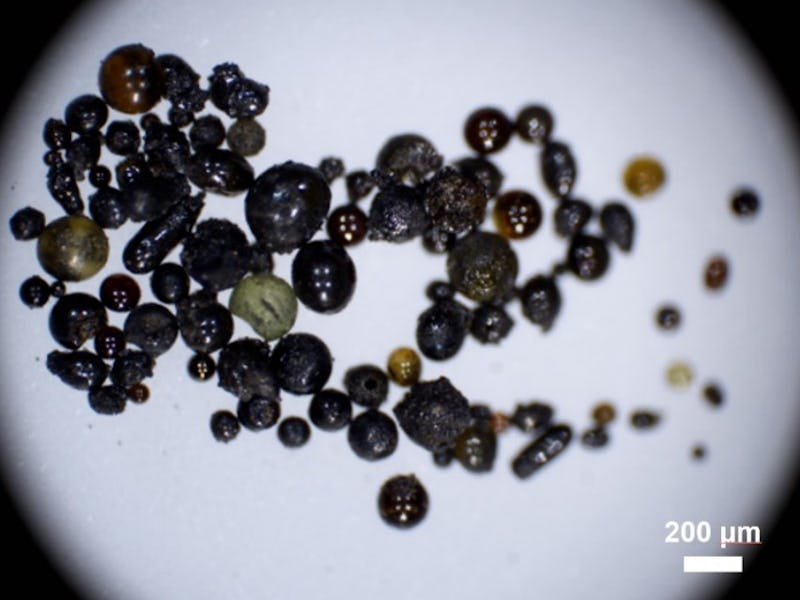Shiny Glass Beads Reveal How the Moon ‘Recharges’ Its Water
Multicolored glass beads that China's Chang'e-5 mission collected from the Moon are revealing clues about an ongoing lunar water cycle.

Shiny glass beads from the Moon are bringing scientists one step closer to understanding how future astronauts might survive the seemingly barren lunar terrain, and how the Solar System evolves today.
A week ahead of NASA’s highly-anticipated Artemis II crew announcement, Nature Geoscience has published a new study about glass beads on the Moon that formed during meteorite impacts over the last several billion years. These microscopic remnants hold evidence of Moon water, and because their rims appear different than their cores, a team led by Chinese researchers suggests that the Sun’s particle spray into space is replenishing the water with quick turnaround.
This stellar mist, known as the solar wind, could be “an efficient water recharge mechanism that could sustain the lunar surface water cycle,” the paper says.
The solar wind is made of charged particles released from the Sun. This is a composite image of the Sun, created with NASA Solar Dynamics Observatory data, from March 24, 2023.
Most people assumed the Moon was a “deserted dry place” until about 15 years ago, Romain Tartèse, study author and planetary scientist at the University of Manchester in the U.K., tells Inverse. But recently, spacecraft and lab studies have suggested its presence, especially at the lunar poles where the environment is colder. The lunar South Pole is where NASA aims to plant its first boots on the Moon since Apollo.
Scientists want to learn the precise distributions of water at the Moon’s surface, whether that looks like ice, ice mixed with lunar dirt (regolith), or water trapped in some regolith material.
“Eventually, the presence of some water at the surface of the Moon could have crucial implications for future human exploration of the Moon,” Tartèse says.
A lunar ferry
The beads they studied are tiny and come in several colors. “These impact glass beads are glass and thus they … shine. Some of the impact glass beads are clear glass, some are not. They have different colors and could be black, green, and orange glass beads,” Hejiu Hui, study author and planetary geochemist at Nanjing University in China, tells Inverse.
These beads come from the lunar samples obtained just a few years ago with China’s Chang’e-5 spacecraft. The lunar dirt reached Earth during the mission’s short 2020 voyage. (The spacecraft is named after Chang’e, the Chinese deity of the Moon.)
The two kilograms of lunar material it collected are the first lunar rock samples to make it to Earth for study since Apollo. They’re also the youngest Moon rocks ever collected.
Lunar soil brought back by China's Chang'e-5 probe sits within a round display at an exhibition on May 17, 2022 in Haikou, Hainan Province of China.
What’s in the beads
The rims of the beads contain chemical signatures that lead the team to suspect that the solar wind is at play.
The team says the solar wind supplies the hydrogen necessary to create Moon water, (the “H” in H2O is hydrogen), and that water enters the beads after it’s created as hydrogen interacts with oxygen at their surfaces. This supports earlier work that also found evidence for the solar wind’s role in forming water on the Moon.
“The hydrogen isotope composition at the rim is similar to the hydrogen isotope composition of solar wind. This similarity suggests the water at the rim derived from the solar wind,” Hui says.
There’s a lot of water at the bead rims, but very little water in the bead cores. This means water is diffusing in the glass, and with that information, scientists could then calculate the speed at which this water moves inward.
They learned something that could be valuable to crewed lunar missions: “introducing water in glass beads at the surface of the Moon is a pretty fast process,” Tartèse says.
Mahesh Anand, co-author and professor of planetary science and exploration at the Open University in the U.K., tells Inverse something similar. “It would only take a few years for this type of water profile to be developed in the lunar glass beads before these beads get preserved in the lunar geological record.”
Hui believes this is an important finding, because it shows that water can be “recharged” within a short turnaround on the Moon’s surface, with implications for its water cycle.
Moon water
The study offers hope that water on the Moon isn’t disappearing when the surface is agitated by disruptions like meteoroid impacts that fling material off the surface, and shows more evidence that solar wind can replenish its water.
The presence of ice on the Moon offers a local resource that future astronauts wouldn’t need to carry with them from Earth. Water is for drinking, but its oxygen could be extracted for breathing, too. Ice could also be converted into a source of fuel.
“As water is the most sought-after commodity for enabling sustainable exploration of planetary surfaces. Knowing how water is produced, stored, and replenished near the lunar surface would be very useful for future explorers to extract and [utilize] it for exploration purposes,” Anand says.
On top of human space exploration, Anand adds that learning about the Moon’s water cycle and the solar wind’s role in replenishing it can deepen astronomers’ understanding of how the Solar System originated, and how it evolves to this very day.